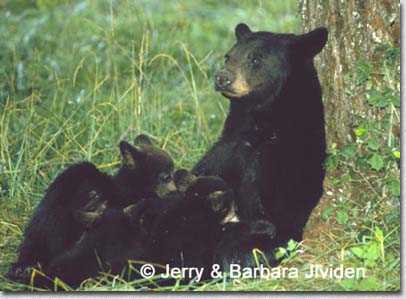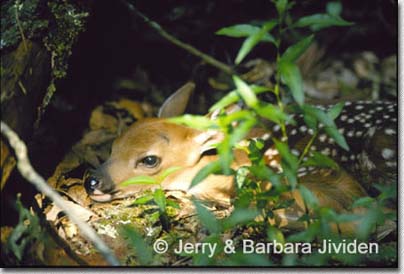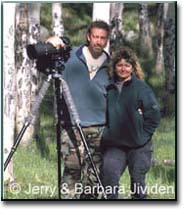|
|
 Feature Article... Mother Nature Poses for the Camera
Text and Photography Copyright Jerry & Barbara Jividen.  Although this Black Bear sow and her cubs were photographed in the Great Smoky Mountains National Park, where public bear sightings are fairly common and frequently photographed, this photo stands out because of the interaction between a mother and her babies. As stock photographers and workshop instructors, we are acutely aware of the need to record natural behavior in wildlife photography whenever possible. With better technologies than ever, photographers--even amateurs--are producing competitive-quality photographs, worthy of marketing.
Although this Black Bear sow and her cubs were photographed in the Great Smoky Mountains National Park, where public bear sightings are fairly common and frequently photographed, this photo stands out because of the interaction between a mother and her babies. As stock photographers and workshop instructors, we are acutely aware of the need to record natural behavior in wildlife photography whenever possible. With better technologies than ever, photographers--even amateurs--are producing competitive-quality photographs, worthy of marketing.
A misconception is, however, that obtaining these behavior shots are just as quick and easy as photographing "typical" snapshots, and that photographers who do record this type of interaction are simply lucky. In truth, luck as very little to do with the overall success--especially "repeatability." It takes time and patience to repeat good results. In some situations, especially where wild animals are somewhat habituated to the presence of people, an animal may graze or wander toward you, offering good photographic opportunities (even if you're using only a 300mm lens).
NOTE: Be careful to not provoke an animal or harass it to cause a desired movement or action. The ethical wildlife photographer is looking for natural behavior, not natural reaction to man. If the animal retreats or modifies its behavior, you need to desist. Image Data - Species: Black Bear (Ursus americanus) We were leading a small group of photographers in a commonly hiked area of the Smokies. After discovering this sow with her cubs, we spent several hours hiking at a distance to her, but moving as she traveled. Periodically, she nursed her cubs and exhibited a relaxed behavior toward us after she was sure that we posed no threat. As a result, we were able to photograph several nursing sequences, as well as the cubs playing and interacting with the sow.
Species: White-tailed Deer (Odocoileus virginianus) After locating this fawn at the base of a tree near a path, our first exposures were taken in subdued light before the sun appeared. But the best images feature this spotlight effect, highlighting the fawn's face. Deer often "bed" their fawns in brushy parts of wooded areas, and the helpless fawns will almost always remain motionless even when potential "threats" are nearby. This natural behavior is a strategy which conceals their presence from predators.
*For a complete listing of upcoming workshops and tours, or for a free copy of "Insights on Images," call (800) 866-8655 or send email through their web site: www.imagesunique.com. |
|
|
 The key is to be patient and remember that you are witnessing and photographing this animal's everyday behavior--its "existence," if you will. And the animal is certainly in no hurry to "perform" in order to sync with your agenda. Allow the animal to accept your presence in its habitat; and allow yourself enough time to not only photograph nature, but for it to unfold naturally. Often, the rewards will be images like this.
The key is to be patient and remember that you are witnessing and photographing this animal's everyday behavior--its "existence," if you will. And the animal is certainly in no hurry to "perform" in order to sync with your agenda. Allow the animal to accept your presence in its habitat; and allow yourself enough time to not only photograph nature, but for it to unfold naturally. Often, the rewards will be images like this. Jerry and Barbara Jividen are the husband-wife team who own and operate Images Unique Photography and Images Unique Wildlife Advantages. In addition to leading photo workshops* and tours, both are certified photography instructors. They market stock photography and produce "how-to" articles for a variety of publications, including NANPA's Currents. Their photography has been published by the National Geographic Books Division, Falcon Press, Voyageur Press, Abbeville Press, Photographer's Market, Outdoor & Nature Photography, Animal Watch, and the Great Smoky Mountains Institute at Tremont. The team also produces "Insights on Images," a professional photography journal (quarterly) for photographers.
Jerry and Barbara Jividen are the husband-wife team who own and operate Images Unique Photography and Images Unique Wildlife Advantages. In addition to leading photo workshops* and tours, both are certified photography instructors. They market stock photography and produce "how-to" articles for a variety of publications, including NANPA's Currents. Their photography has been published by the National Geographic Books Division, Falcon Press, Voyageur Press, Abbeville Press, Photographer's Market, Outdoor & Nature Photography, Animal Watch, and the Great Smoky Mountains Institute at Tremont. The team also produces "Insights on Images," a professional photography journal (quarterly) for photographers.